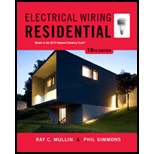
Electrical Wiring Residential
18th Edition
ISBN: 9781285170954
Author: Ray C. Mullin, Phil Simmons
Publisher: Cengage Learning
expand_more
expand_more
format_list_bulleted
Concept explainers
Question
Chapter 2.1, Problem 16R
a.
To determine
State the distance between the finished floor and the receptacles located.
b.
To determine
State the distance of the between the garage floor and the receptacles located.
Expert Solution & Answer
Want to see the full answer?
Check out a sample textbook solution
Students have asked these similar questions
EXERCISE 1: Consider the waveguide of Example
Calculate the phase
constant, phase velocity and wave impedance for TE10 and TM11 modes at the
operating frequency of 15 GHz.
=
192.4 . For
Answer: For TE10, B = 615.6 rad/m, u = 1.531 × 108 m/s, TE
529.4 rad/m, u = 1.78 x 10 m/s, TM = 158.8 Q.
TM11, B
Example 1: A rectangular waveguide with dimensions a = 2.5 cm, b = 1 cm is to
operate below 15.1 GHz. How many TE and TM modes can the waveguide
transmit? if the guide is filled with a medium characterized by
σ = 0, &=4&o Hr = 1°
Calculate the cutoff frequencies of the modes.
lossles
016
X= x+jB
α= 0 B=w/ME
Up=
E =
Free s
space
Mo M, E.Er
K =
Em² Cos(ut-132) az
2 = √μ
=377 √
6
<20
lossy
auto
WE
ليا
+
B = w√ Me [√ 1+ (e) + 1]
0
Sp = =
Mr
B2=
사용
-42
we
333
ov+ jut
E=Eme Cos/wt-Bz) az
Good Conductor
X = B = √TPMN
11
42
6√70
7 20
WE
E=Eml Gos(wt-Bz) az
micro wave.
Chapter 2 Solutions
Electrical Wiring Residential
Ch. 2.1 - What does a plan show about electrical outlets?...Ch. 2.1 - Prob. 2RCh. 2.1 - Prob. 3RCh. 2.1 - Prob. 4RCh. 2.1 - Prob. 5RCh. 2.1 - Prob. 6RCh. 2.1 - Prob. 7RCh. 2.1 - Prob. 8RCh. 2.1 - What methods may be used to mount luminaries to an...Ch. 2.1 - What advantage does a 4 in. octagon box have over...
Ch. 2.1 - What is the size of the opening of a switch...Ch. 2.1 - Prob. 12RCh. 2.1 - Prob. 13RCh. 2.1 - Prob. 14RCh. 2.1 - Prob. 15RCh. 2.1 - Prob. 16RCh. 2.1 - Prob. 17RCh. 2.1 - Prob. 18RCh. 2.1 - Prob. 19RCh. 2.1 - Prob. 20RCh. 2.1 - Prob. 21RCh. 2.1 - Prob. 22RCh. 2.1 - Prob. 24RCh. 2.1 - Prob. 26RCh. 2.1 - Prob. 27RCh. 2.1 - Prob. 28RCh. 2.1 - Prob. 29RCh. 2.1 - Prob. 31RCh. 2.1 - Does the NEC allow metal raceways to be used with...Ch. 2.2 - Prob. 1RCh. 2.2 - What is the size of the footing for the steel...Ch. 2.2 - Prob. 3RCh. 2.2 - Prob. 4RCh. 2.2 - Prob. 5RCh. 2.2 - Prob. 6RCh. 2.2 - How far is the front garage wall from the curb?...Ch. 2.2 - How far is the side garage wall from the property...Ch. 2.2 - Prob. 9RCh. 2.2 - What is the purpose of the I-beams that rest on...Ch. 2.2 - Where is access to the attic provided?...Ch. 2.2 - Prob. 13RCh. 2.2 - Prob. 14RCh. 2.2 - Prob. 15RCh. 2.2 - Prob. 16RCh. 2.2 - What is the stud size for the partitions between...Ch. 2.2 - Who is to furnish the range hood?...Ch. 2.2 - Who is to install the range hood?...
Knowledge Booster
Learn more about
Need a deep-dive on the concept behind this application? Look no further. Learn more about this topic, electrical-engineering and related others by exploring similar questions and additional content below.Similar questions
- micro wave.arrow_forwardDon't use ai to answer I will report you answer pleasearrow_forwardDraw the digital modulation outputs, ASK (Amplitude Shift Keying), FSK (Frequency Shift Keying) and PSK (Phase Shift Keying). For baseband and carrier frequency as shown BASESAND 0 CARRIER 101 wwwwwwwwwwwwwarrow_forward
- Don't use ai to answer I will report you answerarrow_forwardplease explain step by step how ti solve these problems and include good explanations. I am most confused with graphing. Thank you, I will give positive feedback. The rest of the questions to this problem are submitted as a new questions due to the multiple part limitarrow_forwardDon't use ai to answer I will report you answerarrow_forward
- This is the last two questions of a previous question I just sent. Please show step by step with clear explanations as to what to do for these questions. I am very confused. Thank you, I will give positive feedbackarrow_forwardNO AI WILL REJECT(using laplace table only)arrow_forwardNO AI WILL REJECT(using laplace table only)arrow_forward
arrow_back_ios
SEE MORE QUESTIONS
arrow_forward_ios
Recommended textbooks for you
 EBK ELECTRICAL WIRING RESIDENTIALElectrical EngineeringISBN:9781337516549Author:SimmonsPublisher:CENGAGE LEARNING - CONSIGNMENT
EBK ELECTRICAL WIRING RESIDENTIALElectrical EngineeringISBN:9781337516549Author:SimmonsPublisher:CENGAGE LEARNING - CONSIGNMENT

EBK ELECTRICAL WIRING RESIDENTIAL
Electrical Engineering
ISBN:9781337516549
Author:Simmons
Publisher:CENGAGE LEARNING - CONSIGNMENT